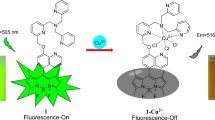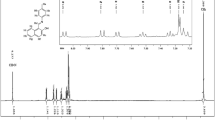Abstract
Invertase is the key enzyme involved in several crucial biological processes by hydrolyzing sucrose for production of glucose and fructose. Invertase plays important roles in the fields of food, pharmacy, cosmetics, biofuels, and agriculture. Detection of invertase activity is urgently necessary for scientific research and industrial processes. Herein, a continuous fluorometric method was developed for real-time detection of invertase activity. 8-Isoquinolinylboronic acid responded to fructose by formation of a fluorescent complex in turn-on manner, and served as a fluorescent sensor to selectively recognize fructose in ternary enzymatic mixture containing sucrose and glucose. The limit of detection (LOD) for fructose was 0.07 mM. Progress curve for fructose production was established by directly and continuously monitoring the fluorescence for invertase reaction with sucrose as substrate. Initial velocity was obtained to characterize invertase activity. LOD for invertase assay was 0.10 U·mL−1. Km and υmax for invertase were determined as 7.70 mM and 0.86 mM·min−1, respectively. Copper ion was demonstrated to inhibit the invertase activity with IC50 of 33.61 mM. Applicability in high-throughput screening for inhibitor was demonstrated. The proposed method allows for real-time, simple, and rapidly monitoring the invertase activity. It has a broad range of potential applications for kinetics and screening inhibitor.
Graphical abstract









Similar content being viewed by others
References
Kulshrestha S, Tyagi P, Sindhi V, Yadavilli KS. Invertase and its applications — a brief review. J Pharm Res. 2013;7(9):792–7.
Zhang L, Wu F, Wanqin Y, Xu Z, Gou XL, Xiong L, et al. Soil invertase and urease activities at different periods in subalpine forest gap in western Sichuan. Shengtai Xuebao/Acta Ecol Sin. 2015;35:3919–25.
Yuan L, Gao Y, Mei Y, Liu J, Kalkhajeh YK, Hu H, et al. Effects of continuous straw returning on bacterial community structure and enzyme activities in rape-rice soil aggregates. Sci Rep. 2023;13(1):2357.
Tan X, Song K, Lu X. Enzymatic activity assay for invertase in synechocystis cells. Bio Protoc. 2018;8(10): e2856.
Xie J, Cai K, Hu H-X, Jiang Y-L, Yang F, Hu P-F, et al. Structural analysis of the catalytic mechanism and substrate specificity of Anabaena alkaline invertase InvA reveals a novel glucosidase*. J Biol Chem. 2016;291(49):25667–77.
Resa P, Elvira L, Sierra C, Espinosa FMd. Ultrasonic velocity assay of extracellular invertase in living yeasts. Anal Biochem. 2009;384(1):68–73.
Aa HT, ArnasonTerra G, editors. A simplified method for measuring secreted invertase activity in Saccharomyces cerevisiae. 2014.
Exnowitz F, Meyer B, Hackl T. NMR for direct determination of Km and Vmax of enzyme reactions based on the Lambert W function-analysis of progress curves. Biochim Biophys Acta (BBA) - Proteins Proteom. 2012;1824(3):443–9.
Ao H, Feng H, Huang X, Zhao M, Qian Z. A reversible fluorescence nanoswitch based on dynamic covalent B-O bonds using functional carbon quantum dots and its application for α-glucosidase activity monitoring. J Mater Chem C. 2017;5(11):2826–32.
Lacina K, Skládal P, James TD. Boronic acids for sensing and other applications — a mini-review of papers published in 2013. Chem Cent J. 2014;8(1):60.
Mulla HR, Agard NJ, Basu A. 3-Methoxycarbonyl-5-nitrophenyl boronic acid: high affinity diol recognition at neutral pH. Bioorg Med Chem Lett. 2004;14(1):25–7.
Kur K, Przybyt M, Miller E. Study of 3-amino phenylboronic acid interactions with selected sugars by optical methods. J Lumin. 2017;183:486–93.
Li J, Nappi AJ. Analysis of monophenol oxidase activity using high pressure liquid chromatography with electrochemical detection. J Liq Chromatogr. 1991;14(11):2089–108.
Rikita T, Egawa Y, Seki T. Fluorometric determination of inulin using 5-quinolineboronic acid and inulinase. Anal Biochem. 2012;426(1):24–6.
Yang W, Yan J, Springsteen G, Deeter S, Wang B. A novel type of fluorescent boronic acid that shows large fluorescence intensity changes upon binding with a carbohydrate in aqueous solution at physiological pH. Bioorg Med Chem Lett. 2003;13(6):1019–22.
Yang W, Lin L, Wang B. A new type of boronic acid fluorescent reporter compound for sugar recognition. Tetrahedron Lett. 2005;46(46):7981–4.
Wu X, Li Z, Chen X-X, Fossey JS, James TD, Jiang Y-B. Selective sensing of saccharides using simple boronic acids and their aggregates. Chem Soc Rev. 2013;42(20):8032–48.
Ramsay WJ, Bayley H. Single-molecule determination of the isomers of d-glucose and d-fructose that bind to boronic acids. Angew Chem Int Ed Engl. 2018;57(11):2841–5.
Shen QJ, Jin WJ. Chemical and photophysical mechanism of fluorescence enhancement of 3-quinolineboronic acid upon change of pH and binding with carbohydrates. Luminescence. 2011;26(6):494–9.
Cheng Y, Ni N, Yang W, Wang B. A new class of fluorescent boronic acids that have extraordinarily high affinities for diols in aqueous solution at physiological pH. Chemistry. 2010;16(45):13528–38.
Ni N, Laughlin S, Wang Y, Feng Y, Zheng Y, Wang B. Probing the general time scale question of boronic acid binding with sugars in aqueous solution at physiological pH. Bioorg Med Chem. 2012;20(9):2957–61.
Geethanjali HS, Melavanki RM, Nagaraja D, Bhavya P, Kusanur RA. Binding of boronic acids with sugars in aqueous solution at physiological pH — estimation of association and dissociation constants using spectroscopic method. J Mol Liquids. 2017;227(1):37–43.
Weitner T, Friganović T, Šakić D. Inner filter effect correction for fluorescence measurements in microplates using variable vertical axis focus. Anal Chem. 2022;94(19):7107–14.
Pontius K, Semenova D, Silina Y, Gernaey K, Junicke H. Automated electrochemical glucose biosensor platform as an efficient tool toward on-line fermentation monitoring: novel application approaches and insights. Front Bioeng Biotechnol. 2020;8:436.
Fellner S, Hentze S, Taggeselle J, Kempin U, Rocktäschel J. Analytical and clinical validation of a BNP assay on the new point-of-care (POC) platform respons®IQ2014.
Hassanvand Z, Jalali F. Simultaneous determination of l-DOPA, l-tyrosine and uric acid by cysteic acid-modified glassy carbon electrode. Mater Sci Eng C. 2019;98:496–502.
Wolfenden R, Yuan Y. Rates of spontaneous cleavage of glucose, fructose, sucrose, and trehalose in water, and the catalytic proficiencies of invertase and trehalas. J Am Chem Soc. 2008;130(24):7548–9.
Cuezzo de Ginés S, Maldonado MC, Font de Valdez G. Purification and characterization of invertase from Lactobacillus reuteri CRL 1100. Curr Microbiol. 2000;40(3):181–4.
Lincoln L, More S. Bacterial invertases: occurrence, production, biochemical characterization, and significance of transfructosylation. J Basic Microbiol. 2017;57(10):803–13.
Manoochehri H, Hosseini NF, Saidijam M, Taheri M, Rezaee H, Nouri F. A review on invertase: its potentials and applications. Biocatal Agric Biotechnol. 2020;25: 101599.
Rasbold L, Heinen P, Silva J, Simão R, Kadowaki M, Maller A. Cunninghamella echinulata PA3S12MM invertase: biochemical characterization of a promiscuous enzyme. J Food Biochem. 2021;45(4): e13654.
Yuan Y, Deng Z, Zhang B, Li G, Zhang J, Liu R, et al. Quality evaluation and geographical classification of immature rape and acacia honeys in China. J Sci Food Agric. 2021;101(13):5446–56.
Shaaban M, Wu Y, Núñez-Delgado A, Kuzyakov Y, Peng Q-A, Lin S, et al. Enzyme activities and organic matter mineralization in response to application of gypsum, manure and rice straw in saline and sodic soils. Environ Res. 2023;224: 115393.
Funding
This work was supported by the Central University Basic Research Fund of China.
Author information
Authors and Affiliations
Corresponding author
Ethics declarations
Conflict of interest
The authors declare no competing interests.
Additional information
Publisher's note
Springer Nature remains neutral with regard to jurisdictional claims in published maps and institutional affiliations.
Supplementary Information
Below is the link to the electronic supplementary material.
Rights and permissions
Springer Nature or its licensor (e.g. a society or other partner) holds exclusive rights to this article under a publishing agreement with the author(s) or other rightsholder(s); author self-archiving of the accepted manuscript version of this article is solely governed by the terms of such publishing agreement and applicable law.
About this article
Cite this article
Chen, Q., Han, M., Yang, Y. et al. Real-time assay of invertase activity using isoquinolinylboronic acid as turn-on fluorescent sensor. Anal Bioanal Chem 415, 5297–5309 (2023). https://doi.org/10.1007/s00216-023-04841-1
Received:
Revised:
Accepted:
Published:
Issue Date:
DOI: https://doi.org/10.1007/s00216-023-04841-1




